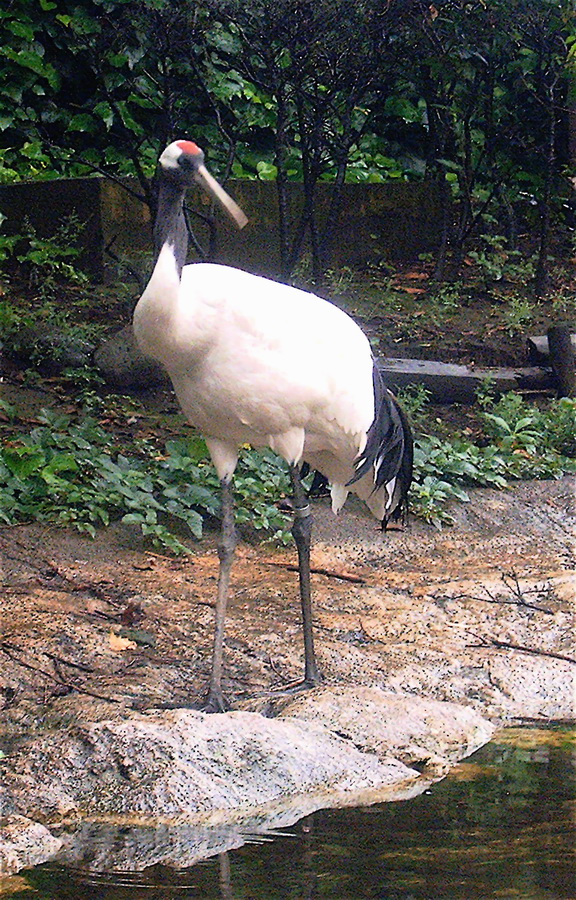|
| Query: grus japonensis | Result: 2nd of 143 | |
Red-crowned Crane (Grus japonensis) - wiki
| Subject: | Red-crowned Crane (Grus japonensis) - wiki
| |

| Resolution: 576x900
File Size: 364037 Bytes
Date: 2005:07:05 19:20:24
Camera: hp 635 Digital Camera (Hewlett-Packard )
F number: f/2.7
Exposure: 1/59 sec
Focal Length: 1440/100
Upload Date: 2007:08:20 14:47:00
|
Red-crowned Crane
From Wikipedia, the free encyclopedia
[Photo] A Red-crowned crane in the Tokyo zoo. Photo by User:Sputnikcccp http://commons.wikimedia.org/wiki/User:Sputnikcccp
The Red-crowned Crane (Grus japonensis), also called the Japanese Crane is a large crane and is the second rarest crane in the world. In East Asia, it is known as a symbol of luck and fidelity. At 55 inches high, the crane does not make easy prey, for all that it stands out in its natural habitat of marshes and swamps. When it matures, the Red-crowned Crane is snow white with a patch of red skin on its head. This patch of skin becomes bright red when the crane becomes angry or excited. An exceptional male weighed 15 kg (33 lbs.), making this the heaviest crane on record, although large Sarus Crane are taller.
In the spring and summer, the Red-crowned Crane lives in Siberia, where their eggs hatch. Normally the crane lays 2 eggs, with only one surviving. Later, in the fall, it migrates in flocks to Korea, Japan, China, Taiwan, and other countries in East Asia to spend the winter. All Red-crowned Cranes migrate, except for a flock that stays in Hokkaid??, Japan, year long.
The crane eats small amphibians, aquatic invertebrates, insects, and plants that grow in marshes and swamps.
Habitat: Marshes, river banks, rice fields, and any place with water, standing dead vegetation, and food.
Population
The estimated population of the species is only 1,700 - 2,000 individuals in the wild, making it one of the most endangered species of bird. The National Aviary in Pittsburgh, Pennsylvania runs a program where U.S. zoos donate eggs which are flown to Russia and raised in the Khinganski Nature Reserve and released into the wild. This program sent 150 eggs between 1995-2005.
Culture
In Japan, this crane, known as tancho, is said to live 1000 years. Coincidentally, a pair of Red-crowned Crane was used as a design in the D series of 1000 yen note. In Ainu language, this crane is known as sarurun kamui or marsh kamui.
In China, the Red-crowned Crane is often featured in myths and legends. In Taoism, the Red-crowned Crane is a symbol of longevity and immortality. In art and literature, immortals are often depicted riding on cranes. A mortal who attains immortality is similarly carried off by a crane. Reflecting this association, Red-crowned Cranes are called xian he, or fairy crane. The Red-crowned Crane is also a symbol of nobility. Depictions of the crane has been found in Shang Dynasty tombs and Zhou Dynasty ceremonial bronzeware. A common theme in later Chinese art is the reclused scholar who cultivates bamboo and keeps cranes.
Because of its importance in Chinese culture, Red-crowned Crane was selected by the National Forestry Bureau of the People's Republic of China as the only candidate for the animal symbol of China. However, recent objections has been raised because of the species' scientific name (Grus japonensis) and common English name ("Japanese crane"), both of which reference Japan, and not China. The proposal is currently being assessed by the State Council.
http://en.wikipedia.org/wiki/Red-crowned_Crane
| The text in this page is based on the copyrighted Wikipedia article shown in above URL. It is used under the GNU Free Documentation License. You may redistribute it, verbatim or modified, providing that you comply with the terms of the GFDL. |
|
^o^
Animal Pictures Archive for smart phones
^o^
|
|

